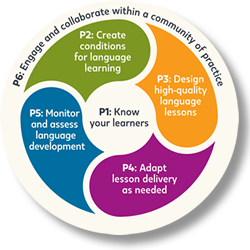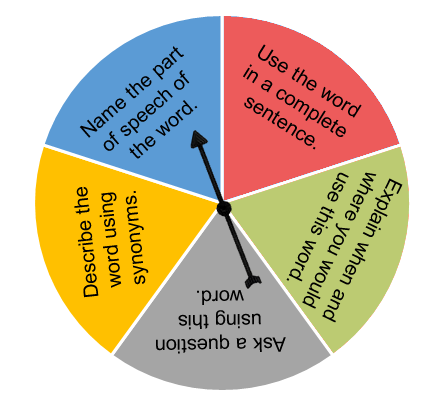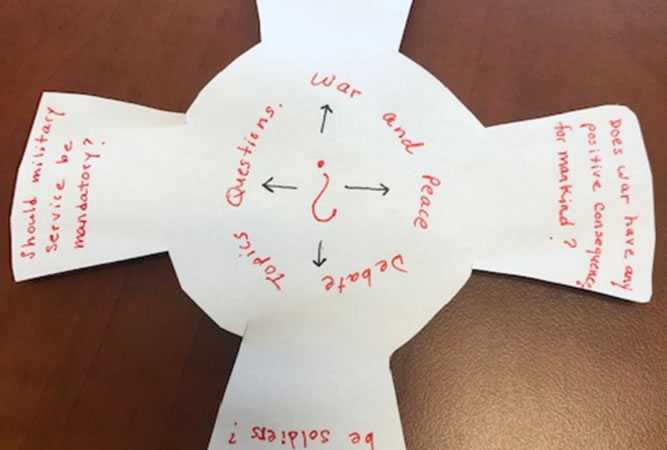4 More Games Inspired by The 6 Principles
by Rita F. Naughton

Now that the school year has begun and students and
teachers alike are falling into a comfortable routine, it is a good time to
reinforce game-based learning through board games inspired by The 6 Principles for
Exemplary Teaching of English Learners®.
This article
is a continuance of “5
Games Inspired by the 6 Principles.” It presents four more
skill-focused board games that provide the advantageous outcomes of
well-designed board games, which
serve to
organize information in a conceptual framework and to make it concrete. They
provide analogies and metaphors to link new information. When played in teams,
members learn together; no one ever feels singled out for not knowing an
answer. (Treher, 2011, p. 4).
Not only do
these four new board games target the aforementioned learning experiences, they
also were designed and administered to fully address TESOL’s 6 Principles: “a
core set of principles that should undergird any program of English language
instruction” that are “universal and establish the foundation for exemplary
teaching of English learners” (TESOL, 2018, p. 2).
 TESOL’s 6 Principles
TESOL’s 6 Principles
Principle 1. Know your learners
Principle 2. Create conditions for language learning
Principle 3. Design high-quality lessons for language development
Principle 4. Adapt lesson delivery as needed
Principle 5. Monitor and assess student language development
Principle 6. Engage and collaborate within a community of practice
The
following four “wheel” games facilitate exposure and practice in grammar,
culture, vocabulary, and question skills. Each one of them is inspired by The 6
Principles and promotes game-based education, which “provides learners with an
experience, as well as a chance to reflect on that experience and draw
knowledge, build new attitudes, skills or ways of thinking based on it”
(Boghian et al., 2019, p. 55).
1. Grammar Wheel
This game is an information gap activity in which
the students need to provide the missing grammatical element to a set of
sentences.
Steps
-
 Prepare five numbered sets of
cards placed in five different piles in the shape of a circle. In each pile,
there will be a command card indicting the task to complete:
Prepare five numbered sets of
cards placed in five different piles in the shape of a circle. In each pile,
there will be a command card indicting the task to complete:
-
Add the missing verb in the sentence (Example: The rain
_____ continue until this evening. Do you _____ an umbrella?)
-
Add the missing noun in the
sentence (Example: I have been to Japan five ________.)
-
Correct the verb error in
the sentence (Example: Maria must takes her vitamins every day.)
-
Correct
the noun in the sentence (Example: Don’t forget to do all your
homeworks.)
-
Transform the statement
into a question (Example: Josh is working in the office today.)
-
Students work in groups of two to four. Each team will
receive a grammar wheel “number” spinner and the five sets of cards. Provide
paper and pencil for cards that require writing down the answer for
clarification.
-
Each team decides which
player goes first. The first player spins the wheel and waits for the arrow to
land on a number. The number the arrow lands on indicates the card group.
-
The student player selects
the top card from that pile, reads the card, and provides the missing
information. The team checks the answer and you verify.
-
If
the answer is correct, the student keeps the card. If the answer is incorrect,
the card goes on a separate “finished” pile. The game continues until all the
cards are read.
-
The team with the most
cards is the winner.
How Does Grammar Wheel Address The 6 Principles?
- Principle 1: This game allows for the gathering of linguistic, educational, and personal information to better know your learners.
-
Principle 2: It creates a welcoming environment for language learning and acclimates the learners in a new learning environment. This game is an ideal icebreaker.
-
Principle 3: This grammar bingo game communicates learning objectives and integrates language learning and content to further language development.
-
Principle 4: This game is versatile; it can be adapted to fit many grammatical structures and learners’ proficiency levels.
-
Principle 5: This game facilitates the monitoring and assessing of the language progress. The teacher can note errors and provide appropriate feedback.
2. Culture Wheel Game
This game targets cultural awareness and sensitivity while at the same time presenting the opportunity to practice listening, speaking, reading, and writing. The wheel is accessed online (wheeldecide.com) and is dependent upon each player having a cultural item to share and explain.
Steps
-
This online game involves forming groups of three to six students. The categories on the wheel are as follows, but feel free to add more categories if you think they will help you get to know your students:
Categories
Description (5 min.)
History (5 min.)
Personal meaning (5 min.)
Cultural Significance (5 min.)
-
Spin the online wheel (see Figure 1), which is projected on a monitor/screen for all students to see; then have a student read the category it lands on.

Figure 1. Online wheel spinner. (From wheeldecide.com.)
-
One at a time, in their small groups, students relate the category on the wheel to their cultural item, explaining their item clearly and descriptively to their group members. Each turn should take about a minute, but give students up to 5 minutes if they need more time.
-
The game continues until all the group members have had a chance to share their cultural items.
-
A possible follow-up activity is to have the students write a descriptive essay about the sharing of the cultural item.
How Does the Culture Wheel Game Address The 6 Principles?
-
Principle
1: This game allows the teacher to learn about students’
cultures and cultural practices.
-
Principle
2: This game allows for cultural learning and creating an
environment of trust and rapport for language learning.
-
Principle
3: The culture wheel can be used with other terms and as an ice
breaker, review, or a culminating activity for a unit.
3. Vocabulary Game Wheel
This game targets five different ways to learn vocabulary words.
Steps
-
Form groups of two to three students. Each group receives a vocabulary wheel (see Figure 2) and a list of their vocabulary words. You can make a vocabulary wheel by using the SmartArt “cycle” graphic on Microsoft Word. Following are the vocabulary commands:
-
Name the part of speech of the word.
-
Use the word in a complete sentence.
-
Explain when and where you would use this word.
-
Ask a question using this word.
-
Describe the word using synonyms.

Figure 2. Vocabulary wheel.
-
Students take turns spinning the vocabulary wheel.
-
Using the vocabulary list, students will take a vocabulary word and complete the command indicated on the wheel once the arrow stops spinning. If the arrow falls in the middle of a command, the students are to follow the command on the right.
-
Students are to record their answers. Check the answers at the end of the game. The student with the most correct and appropriate responses wins
-
The game will continue until there are no more vocabulary words on the list.
How Does the Vocabulary Wheel Address The 6 Principles?
-
Principle
2: The vocabulary wheel gives student the opportunity to
have fun exploring multiple facets of vocabulary words.
-
Principle
3: This game lends itself to writing and reading activities in which
the students use the vocabulary words to further their language
development.
-
Principle
5: The vocabulary wheel game allows both students and teacher to
monitor and assess vocabulary knowledge.
4. Question Wheel
This wheel game is created to fit the content of a humanities course. Its purpose is to explore complex questions. The wheel used in this example (Figure 3) featured questions on war and peace:
- Does war have any positive consequences for mankind?
- Do you think women should be soldiers?
- Should military service be mandatory?
- Should all citizens be required to vote?

Figure 3. War and peace debate topics questions wheel.
Steps
-
Give each group of three to four students a question wheel featuring four debatable questions, as well as a sheet of paper with six columns:
-
Question
-
Yes
-
No
-
Reason 1
-
Reason 2
-
Reason 3
-
Students take turns spinning the wheel. When the arrow on the wheel stops at a question, the student reads the question aloud and then finds the question on the question sheet.
-
The students in the group then each determine whether they agree with the question (Yes) or disagree with the question (No), write the reasons on their sheet of paper, and share aloud with their group members. They each discuss their reasons, and answers can be changed depending on the discussion information.
-
Game continues until all the questions have been answered.
How Does Question Wheel Address The 6 Principles?
-
Principle
1: Through this game, the teacher learns about their students’
personal beliefs and opinions regarding important topics.
-
Principle
2: This game gives students a chance to play a game that deals with
critical thinking questions in an engaging way.
-
Principle
3: This game is an appropriate prewriting activity for a writing
assignment, and students show how they can justify their opinions with support
and conviction, sourcing their prior knowledge and beliefs.
Conclusion
These 6 Principle–inspired wheel games foster language learning and development. They follow the model of a well-designed board game, which according to Cassie (2018) can be “particularly effective at keeping reluctant learners engaged because they keep the learner close to but not over their threshold of capacity” (para. 13). Additionally, they are true to The 6 Principles in promoting exemplary teaching through knowledge, innovation, design, adaptation, monitoring, and engagement.
References
Boghian I., Cojocariu, V.-M., Popescu, C. V.,
& Mâţӑ, L. (2019). Game-based learning. Using board games in adult
education. Journal of Educational Sciences & Psychology,
9(1), 51–57.http://jesp.upg-ploiesti.ro/index.php?option=com_phocadownload&view=file&id=516:gamebased-learning-using-board-games-in-adult-education&Itemid=16
Cassie, J.
(2018, February). Playing games with formative assessment.Educational Leadership, 75(5), 58–63.
TESOL
International Association (TESOL). (2018). The 6 principles for
exemplary teaching of English learners: Grades K–12.
Treher, E. N. (2011).Learning with board games: Tools for learning and
retention. The Learning Key.
Rita Naughton teaches as an associate professor in the Intensive English, Undergraduate Bridge and Master TESOL Program at Southern New Hampshire University. Her scholarly interests include academic research writing, metacognitive learning strategies, ESL writing workshop programs, and assessment and evaluation practices, as well as incorporating learning games for motivation and success in the English language classroom.